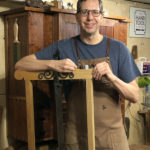Stretch Out those Legs, We're Gonna Turn!
There are so many great furniture projects out there that have turned elements. These round sections can be done by hand using chisels and spokeshaves, but nothing beats a lathe for speed and consistency. Lathes have been around for thousands of years so there are many options open for the hand tool woodworker. This semester will tackle the art of turning and will start by comparing spring pole and treadle lathes, then build an 18th century treadle lathe with some modern hardware and finish with an iconic table as a perfect introduction to turning furniture parts. We will need to build our lathes first before we can get into the lessons so the whole thing will be backwards unlike previous semesters.
The turning tool lesson alone is worth the price of admission to Semester 5! But then the lessons just keep going and I'm amazed at how much information is here. Prior to this I had never turned and now I feel I'm ready to turn anything.
Member Since 2012
Work at Your Own Pace
What makes the lesson in The Hand Tool School so effective is that they never go away. When you buy a semester you have lifetime access to the material. No need to worry about cramming in all the content before access goes away or how much it will cost you in monthly fees to get through all the material. And there is A LOT of material in Semester 5.
The techniques taught in semester 5 represent an entirely new direction of woodworking. Woodturning can be a subculture all its own but foot powered lathes will hone your turning skills even farther when we discover that high RPM and torque often disguise poor technique and dull tools.
Lessons, Projects, & Tools
- Applied Projects
- Pole Lathe
- Flywheel Lathe
- Pedestal Table
- Tool List
Lesson 1: Introduction to Turning Tools
This lesson discusses the wide variety of turning tools from roughing and spindle gouges to skew chisels and specialty hollowing tools. We will take a close look at how the tools cut, how the geometry of the blade effects the cut, and the body language needed to ensure a clean, consistent cut. We will even compare “traditional” turning tools with modern, replaceable carbide tip tools.
Lesson 2: Sharpening Turning Tools
Despite the complex geometry of some turning tools, they are quite easy to sharpen when compared with the variety of flat work tools used by cabinetmakers. We will discuss my sharpening process, when to sharpen, tools to use, and how to create repeatability to reduce sharpening time. Finally we will add a grinding wheel attachment to our treadle lathe.
Lesson 3: Spindle Turning
This lesson looks at all the aspects of turning between centers from preparing and securing the work piece to the actual cutting techniques to shape beads and coves. We also compare and contrast spindle turning on the spring pole and treadle lathes.

Lesson 4: Faceplate Turning
Turning with a chuck or a mandrel is a very different style and requires different tools and rock solid work holding. These techniques are even more important when foot powered lathes are used.
Lesson 5: Foot Powered Turning 101
You secure the workpiece and start it turning, that’s all there is to it right? Not quite. This lesson takes a look at the differences in technique and stock preparation between electric powered lathes and foot powered lathes. We also look closely at the differences between spring pole and treadle lathe turning. Basically we will cover the…um…basics to getting started turning on a foot powered lathe.
An Unmatched Learning Experience
I firmly believe that if you follow each lesson, do the practice exercises, and build the projects you will be a better woodworker at the end of it. I think that dedicating 4-6 months to get through all the lessons and projects is a reasonable goal as well.
Of course I'll be here every step of the way answering your questions. Ask any of my students, I'm always ready to help.
The hand tool school has been an amazing resource. The first few semesters are a video anthology of how to accomplish any task by hand. I used to dread sawing by hand and be totally incapable of getting square cuts. With Shannon’s tutelage, I’m a confident sawyer and repeat the Hand Tool School mantra to everyone: “If you can see the line, you can saw to the line.”
Member Since 2014
But there is also a community of your peers waiting for you to share your triumphs, project pictures, and to help you when you have troubles. If you are struggling with a technique or project, many of them are building the same thing or have already built it and can offer advice.





















